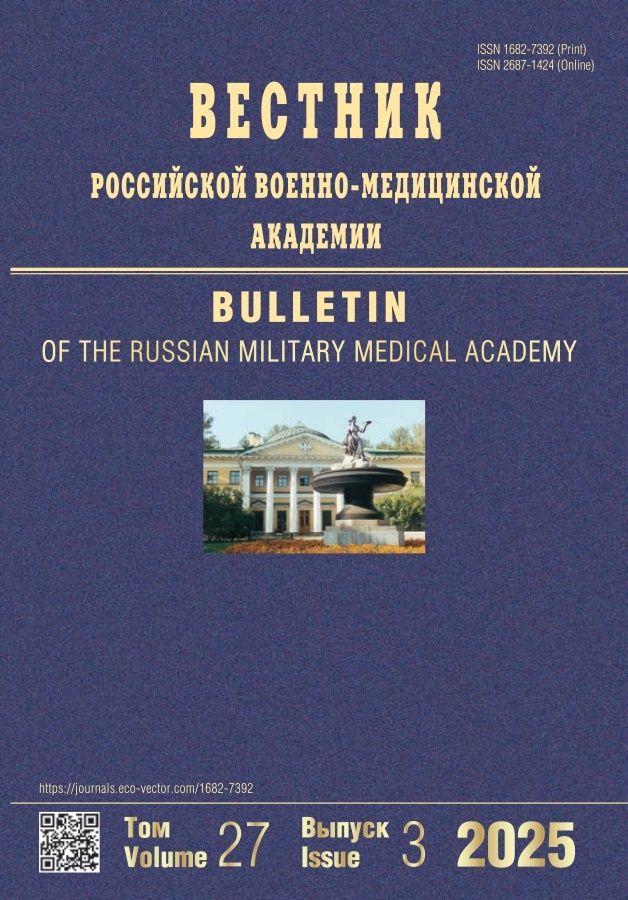Клиническое применение иммунной плазмы при септических состояниях
- Авторы: Скрипай Л.А.1, Вильянинов В.Н.1, Бельгесов Н.В.1
-
Учреждения:
- Военно-медицинская академия им. С.М. Кирова
- Выпуск: Том 22, № 3 (2020)
- Страницы: 127-131
- Раздел: Экспериментальные исследования
- URL: https://journals.rcsi.science/1682-7392/article/view/50548
- DOI: https://doi.org/10.17816/brmma50548
- ID: 50548
Цитировать
Аннотация
Резюме. Рассматривается эффективность клинического применения иммунной плазмы по сравнению с обычной свежезамороженной плазмой при септических состояниях. Установлено, что использование иммунной плазмы при лечении больных, страдающих септическими осложнениями, на фоне антибиотикотерапии более эффективно, чем применение обычной свежезамороженной плазмы. У больных, которым переливалась иммунная плазма, отмечалось значительное снижение показателей воспалительной реакции крови (уменьшение лейкоцитоза, скорости оседания эритроцитов, С-реактивного белка), снижался также и уровень прокальцитонина. Уровень общего белка, наоборот, после каждого переливания данного компонента увеличивался. У пациентов, которым переливалась свежезамороженная плазма, положительных изменений показателей воспалительной реакции крови не было (количество лейкоцитов и скорость оседания эритроцитов после каждого переливания увеличивались, изменения С-реактивного белка были незначимы). Уровень прокальцитонина и общего белка после каждой инфузии возрастал. У всех больных, которым переливали компоненты крови, на фоне антибиотикотерапии на результат лечения также оказывало влияние количество микроорганизмов, высеянных из раневой поверхности при первичном бактериологическом посеве. В целом при септических состояниях переливание иммунной плазмы было более эффективно, чем переливание свежезамороженной плазмы. Этот эффект по нормализации лабораторных показателей крови наблюдался при меньшем среднем объеме переливаемой иммунной плазмы (0,58 л) по сравнению с большим среднем объемом (0,83 л) переливаемой свежезамороженной плазмы.
Полный текст
Открыть статью на сайте журналаОб авторах
Л. А. Скрипай
Военно-медицинская академия им. С.М. Кирова
Автор, ответственный за переписку.
Email: vmeda-nio@mil.ru
Россия, Санкт-Петербург
В. Н. Вильянинов
Военно-медицинская академия им. С.М. Кирова
Email: vmeda-nio@mil.ru
Россия, Санкт-Петербург
Н. В. Бельгесов
Военно-медицинская академия им. С.М. Кирова
Email: vmeda-nio@mil.ru
Россия, Санкт-Петербург
Список литературы
- Волков, А.М. Прогнозирование и профилактика гнойно-септических осложнений после коронарного шунтирования: дис. … канд. мед. наук / А.М. Волков. – СПб.: ВМА, 2002. – 170 с.
- Ерюхин, И.А. Опыт медицинского обеспечения войск в Афганистане 1979–1989 гг. Организация и объем хирургической помощи / И.А. Ерюхин, В.И. Хрупкин, С.П. Калеко. – М.: ГВКГ им. акад. Н.Н. Бурденко, 2002. – 358 с.
- Козлов, В.К. Сепсис: этиология, иммунопатогенез, концепция современной иммунотерапии / В.К. Козлов. – СПб.: Диалект, 2008. – 148 с.
- Попов, Д.А. Ускоренный способ идентификации возбудителей бактериемий с применением метода газовой хромато-масс-спектрометрии / Д.А. Попов [и др.] // Клин. лаборат. диагн. – 2013. – № 5. – С. 55.
- Патент № 2665170 Российская Федерация, МПК G01N 33/53 (2018.02). Способ лечения пациентов с осложнениями внутригоспитальными инфекциями / Н.В. Бельгесов [и др. ]; опубл. 28.08.2018 г., бюлл. № 25.
- Тец, В.В. Клеточные сообщества / В.В. Тец. – СПб.: СпецЛит, 1998. – 15 с.
- Dellinger, R.P. Surviving Sepsis Campaign: International Guidelines for Management of Severe Sepsis and Septic Shock, 2012 / R.P. Dellinger [et al.] // Intensiv. Care Med. – 2013. – № 1. – Р. 9.
- Kumar, A. Duration of hypotension before initiation of effective antimicrobial therapy is the critical determinant of survival in human septic shock / A. Kumar [et al.] // Crit. Care Med. – 2006. – № 34 (6). – Р. 96.
- Li, J. Addressing the risk of bacterial contamination in platelets: hospital economic perspective / J. Li // Transfusion . – 2017. – № 10. – Р. 2321–2328.
- Taur, Y. Intestinal Domination and the Risk of Bacteremia in PatientsUndergoing Allogeneic Hematopoietic Stem Cell Transplantation / Y. Taur // Clinical Infectious Diseases. – 2012. – № 7. – P. 905–914.
- Wallet, F. Preliminary clinical study using a multiplex real-time PCR test for the detection of bacterial and fungal DNA directly in blood / F. Wallet [et al.] // Сlin. Microbiol. Infect. – 2010. – № 16 (6). – Р. 9.
Дополнительные файлы












